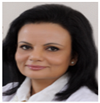
Geeta Shroff
Nutech Mediworld, India
Title: Validating the efficacy of the Human Embryonic Stem Cell (hESC) therapy in cerebral palsy patients
Biography
Biography: Geeta Shroff
Abstract
Introduction: We have previously shown that hESCs have the potential to treat Cerebral Palsy (CP) related neurological impairments. Here, we focus on the validation of efficacy of hESC therapy in patients with CP. Methodology: This was a record based study (October 2007 to July 2013) of 101 CP patients (age <54 years). hESCs were given in four treatment sessions (T1- T4). The variables “ILLNESS” (How ill at start) and “EMENDMENT” (How emended at end of session) were analyzed. Results: Of 101 patients, 73 attended T2, 41 attended T3 and 15 attended T4. For T1, the average duration of therapy (TD 1) was 60 days. At the end of T1, patients had improved by ~180% from baseline. Similarly, for T2, T3 and T4 (TD 2, 3 = 59 days; TD 4 = 60 days), an improvement by 162%, 153% and 170%, respectively from end of previous session was noted. During T1, T2, T3 and T4 the “ILL” patients, who were ‘severe’ (53, 36, 20, and 6) at admission, emended as endured (40, 28, 17, and 5) and profuse (13, 8, 3, and 1) at discharge. Moderate “ILL” patients (48, 48, 2, and 9) at admission emended as “profuse” (36, 28, 17, and 7) and “endured” (12, 9, 4, and 2) at discharge. For severe cases at admission, the odds of profuse emending when therapy ended were 0.11, 0.09, 0.75, and 0.04 times lower than the cases that were moderate at admission. Conclusion: hESCs therapy caused betterment in the condition of CP patients compared to first admission during each session.
